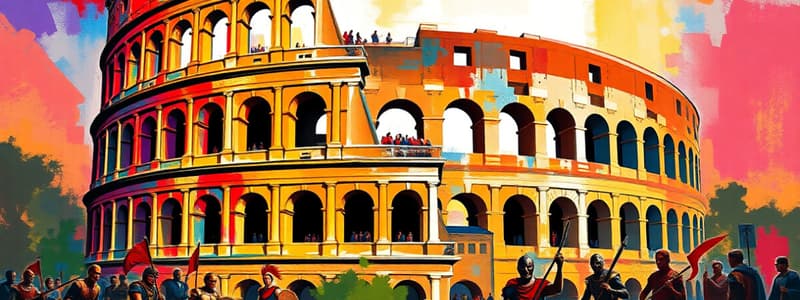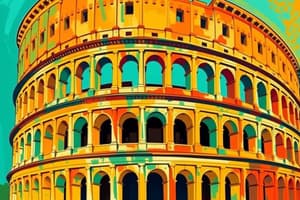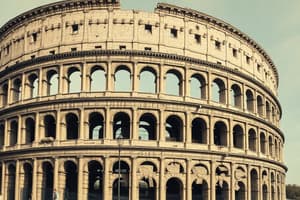Podcast
Questions and Answers
What was the original name of the Colosseum?
What was the original name of the Colosseum?
The Flavian Amphitheater
How tall was the statue of Colossus of Nero?
How tall was the statue of Colossus of Nero?
- 100 foot
- 140 foot
- 80 foot
- 120 foot (correct)
Approximately how long did it take to build the Colosseum?
Approximately how long did it take to build the Colosseum?
10 years
Which dynasty ruled Rome when construction of the Colosseum began
Which dynasty ruled Rome when construction of the Colosseum began
Under whose rule was the Colosseum completed?
Under whose rule was the Colosseum completed?
Approximately how many spectators could the Colosseum hold?
Approximately how many spectators could the Colosseum hold?
The Colosseum was primarily used for chariot races.
The Colosseum was primarily used for chariot races.
Who were the gladiators commonly?
Who were the gladiators commonly?
What was the Colosseum used as after the fall of Rome?
What was the Colosseum used as after the fall of Rome?
Approximately how tall is the exterior travertine shell of the Colosseum?
Approximately how tall is the exterior travertine shell of the Colosseum?
Which of the following Greek orders are part of arches in the Colosseum, from the ground up?
Which of the following Greek orders are part of arches in the Colosseum, from the ground up?
What does the Colosseum represent to most people today?
What does the Colosseum represent to most people today?
Name one type of person who participated in the spectacles in the Colosseum?
Name one type of person who participated in the spectacles in the Colosseum?
Name one typical Roman building practice reflected in the exterior of the Colosseum?
Name one typical Roman building practice reflected in the exterior of the Colosseum?
Flashcards
Colosseum's Name
Colosseum's Name
Originally named the Flavian Amphitheater, it was later renamed due to its location beside the Colossus of Nero.
Colosseum Construction Timeline
Colosseum Construction Timeline
Construction started around 70 A.D. and completed in 80 A.D., spanning about 10 years.
Colosseum's Emperors
Colosseum's Emperors
Founded by Vespasian, continued by Titus. This was the Flavian Dynasty.
Colosseum Capacity
Colosseum Capacity
Signup and view all the flashcards
Colosseum Events
Colosseum Events
Signup and view all the flashcards
Gladiators
Gladiators
Signup and view all the flashcards
Animal Hunts in Colosseum
Animal Hunts in Colosseum
Signup and view all the flashcards
Numbered Gateways
Numbered Gateways
Signup and view all the flashcards
Seating Arrangement
Seating Arrangement
Signup and view all the flashcards
Colosseum Substructures
Colosseum Substructures
Signup and view all the flashcards
Concrete and Vaulted Corridors
Concrete and Vaulted Corridors
Signup and view all the flashcards
Colosseum's Later Use
Colosseum's Later Use
Signup and view all the flashcards
Colosseum Height
Colosseum Height
Signup and view all the flashcards
Colosseum Exterior
Colosseum Exterior
Signup and view all the flashcards
Column Order
Column Order
Signup and view all the flashcards
Roman applied Greek order.
Roman applied Greek order.
Signup and view all the flashcards
Colosseum's Symbolism
Colosseum's Symbolism
Signup and view all the flashcards
What was the Colosseum originally called?
What was the Colosseum originally called?
Signup and view all the flashcards
Reason for the name change of the Colosseum?
Reason for the name change of the Colosseum?
Signup and view all the flashcards
Who built the Roman Colosseum?
Who built the Roman Colosseum?
Signup and view all the flashcards
Who (or what) fought in the Colosseum?
Who (or what) fought in the Colosseum?
Signup and view all the flashcards
How did social class dictate seating?
How did social class dictate seating?
Signup and view all the flashcards
What was housed beneath the Colosseum floor?
What was housed beneath the Colosseum floor?
Signup and view all the flashcards
How were concrete and arches essential?
How were concrete and arches essential?
Signup and view all the flashcards
What gives away the bones of the colosseum?
What gives away the bones of the colosseum?
Signup and view all the flashcards
What elements define the Colisseum's facade?
What elements define the Colisseum's facade?
Signup and view all the flashcards
List the Column orders of the Colossem
List the Column orders of the Colossem
Signup and view all the flashcards
What did columns bring to the facade?
What did columns bring to the facade?
Signup and view all the flashcards
What does the Colosseum symbolize?
What does the Colosseum symbolize?
Signup and view all the flashcards
How does the Colosseum show Roman architecture?
How does the Colosseum show Roman architecture?
Signup and view all the flashcards
Study Notes
- The Colosseum is located in Rome, Italy
- Initially named the Flavian Amphitheater, it was renamed due to its location near the Colossus of Nero
- The Colossus of Nero was a 120-foot tall statue
- Construction started in 70 A.D. and took about 10 years
- The Flavian Dynasty, starting with Emperor Vespasian, ruled Rome for over 25 years
- The Flavian family funded the construction
- Titus, Vespasian's son, completed the Colosseum in 80 A.D.
- The Colosseum could accommodate over 50,000 spectators
- It served as an amphitheater for gladiatorial combats and animal hunts during the Roman Empire
- Gladiators, often slaves, were professional fighters trained in hand-to-hand combat
- Helpless prisoners and wild animals were participants in animal hunts
- Animals were sometimes pitted against each other
- Numbered gateways allowed efficient entrance and exit
- Spectators were seated according to social hierarchy, with elite closest to the arena and commoners on the top floor
- Substructures beneath the arena floor housed waiting rooms, animal cages, and machinery for raising sets, animals, and humans
Architecture
- The Colosseum was built using concrete
- Barrel-vaulted corridors supported the oval seating area
- The Colosseum served as a quarry for building materials after the fall of Rome
- Marble seats were removed, revealing vaults
- The exterior travertine shell is approximately 160 feet tall, equivalent to a 16-story building
- The facade combines Roman arches and Greek columns
- The facade is divided into 4 bands with arched openings on the lower 3
- Greek orders (Tuscan, Ionic, Corinthian) frame the arches in the Roman sequence
- Framing with Greek orders was mainly for adding variety
- The multi-storied facade is unified by verticals and horizontals
- The Colosseum represents Rome to most people
Studying That Suits You
Use AI to generate personalized quizzes and flashcards to suit your learning preferences.
Related Documents
Description
Explore the Colosseum's history, from its construction by the Flavian Dynasty, its original name, its capacity for over 50,000 spectators, and its use for gladiatorial combats and animal hunts during the Roman Empire. Learn about the gladiators, the seating arrangements, and the numbered gateways facilitating entry and exit.




